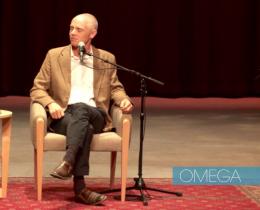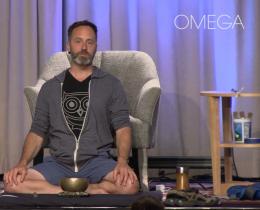Omega: What’s the difference between contemplative practice and meditation?
Mirabai: Meditation is one of many contemplative practices. When we started The Center for Contemplative Mind in Society, we chose the word contemplative because we were helping to bring these practices into mainstream American life. At that time, we felt like using the word meditation would marginalize what we were trying to do. Although when we did focus groups, we found out that most Americans think of the word “contemplative” as what you do before you buy a new car! We now have a tree of contemplative practices on our website. We clustered the different practices by type. It includes everything from silence and meditation to yoga, journaling, and deep listening.
Omega: How do you talk about these practices with different audiences?
Mirabai: I’ve taught many different professional groups—journalists, scientists, lawyers, judges, social justice activists, and educators. In each case, it’s important to learn the culture people are living in, to look at how they understand things, and then to adapt your language.
The core of the teachings is universal, but being able to talk about them in different ways is helpful and decreases barriers to learning. When we started the center in 1995, many people we worked with had never done any of these practices and didn't know anyone who had ever done these practices.
We worked with a green group that had CEOs of national environmental organizations, like the NRDC and the Wilderness Society. We taught a few different forms of meditation to them, and they talked about their inner environment and inner habitat. That's how they understood exploring their minds.
We started teaching at Google in 2007, and the neuroscience research on meditation in the mind and body was just starting to come out. We framed all the practices there with a lot of the research and that really helped them because that’s the way they think.
One time I was standing in line for lunch during a day-long workshop for Google’s program, which we called Search Inside Yourself. It is a good name for a meditative practice for a company that's all about search. I was standing in line between two young engineers and one said to the other, “How was that for you?” And the second guy said, “Great! I defragged my hard drive.”
Omega: What has your experience been bringing these practices into educational settings?
Mirabai: With higher education it depends on the discipline. You talk about it one way if you're teaching mindful economics and another way for mindfulness in physics. Arthur Zajonc, who was one of the founders of our higher education program, teaches physics at Amherst College. He would get his students interested by talking about how Einstein needed to cultivate sustained attention before he could have those breakthrough moments that led to his theory of relativity. Then he talked to them about how these practices can help cultivate sustained attention.
We did a lot of mindful strategy at The Smith College School for Social Work because that’s what they do. Social workers are good at listening, but by learning mindful listening, they really move to the next level. With them we also focused on self-care. Many caregivers have a hard time taking care of themselves.
I was teaching incoming students at Amherst College where they do a 3-day orientation intensive. Each year for the last several years, 70 out of 400 incoming students have chosen mindfulness and yoga as their orientation program. I teach it with a friend of mine who teaches yoga. The first year I taught, they were really kind of holding back. I'd ask if there were any questions, and no one would put a hand up. It’s the very first week of school in such a competitive experience.
The next year I asked George Mumford, who wrote a book called The Mindful Athlete to join me. He is the meditation teacher who taught the Chicago Bulls and the Los Angeles Lakers with Phil Jackson. A lot of the students in the class were athletes. He came in and he talked about how being a great athlete isn’t just being able to put the ball in the basket, but it’s about knowing yourself and knowing your teammates. They really listened to him.
Then we could do the rest of the training, and they had this understanding that contemplative practices could really help them excel in whatever they were doing and could help them be good leaders because they would be able to better understand themselves and others.
Omega: How can issues of race, diversity, and inclusion be addressed by mindfulness, contemplative practices, and compassion?
Mirabai: What we're seeing now in higher education is that sitting quietly in silence, looking at your mind, is helpful for many people, but there are many who aren't comfortable with it and don't really learn much from it. There is a wide range of contemplative practices—from movement-based practices to storytelling from a contemplative space to ritual-based practices—in addition to the quieter practices. There's a growing movement to look at using and designing culturally appropriate contemplative practices for different groups.
At The Center for Contemplative Mind in Society, we have been encouraging people to deepen their own practices, whatever they are, and from that, they'll know how to bring it into their classrooms.
One of our board members, Michelle Chatman, is a professor at the University of the District of Columbia. Most of her students are African American. Her own practice comes from the Yoruba tradition, and from what I understand, the honoring of ancestors is central to that tradition. She knew that she couldn't bring Yoruba practice into a secular classroom, but she wanted to bring the spirit of it in.
In her anthropology class, she had her students each create a family tree. First, she had them sit quietly and remember different members of their family and just feel themselves rooted in their family. Then they drew the tree and put on as many members as they knew. Through that they saw how much they knew and how much they didn't know about their family. Then she had them do contemplative interviews with the people on their tree that they could reach. They came back into the classroom and shared with each other what they discovered.
They did all this in a way that allowed them quiet space to express themselves and to look at whatever emotions arose. She reported it was really powerful and very effective.
Many contemplative practices like this one are being discovered and developed by faculty and are emerging out of their particular disciplines. The practice Chatman introduced in her classroom helps students explore and investigate their various identities, including what aspects have been repressed and what aspects they may want to celebrate. In addition, individual practice of this exercise can lead the students to a sense of the interconnection of all life.



